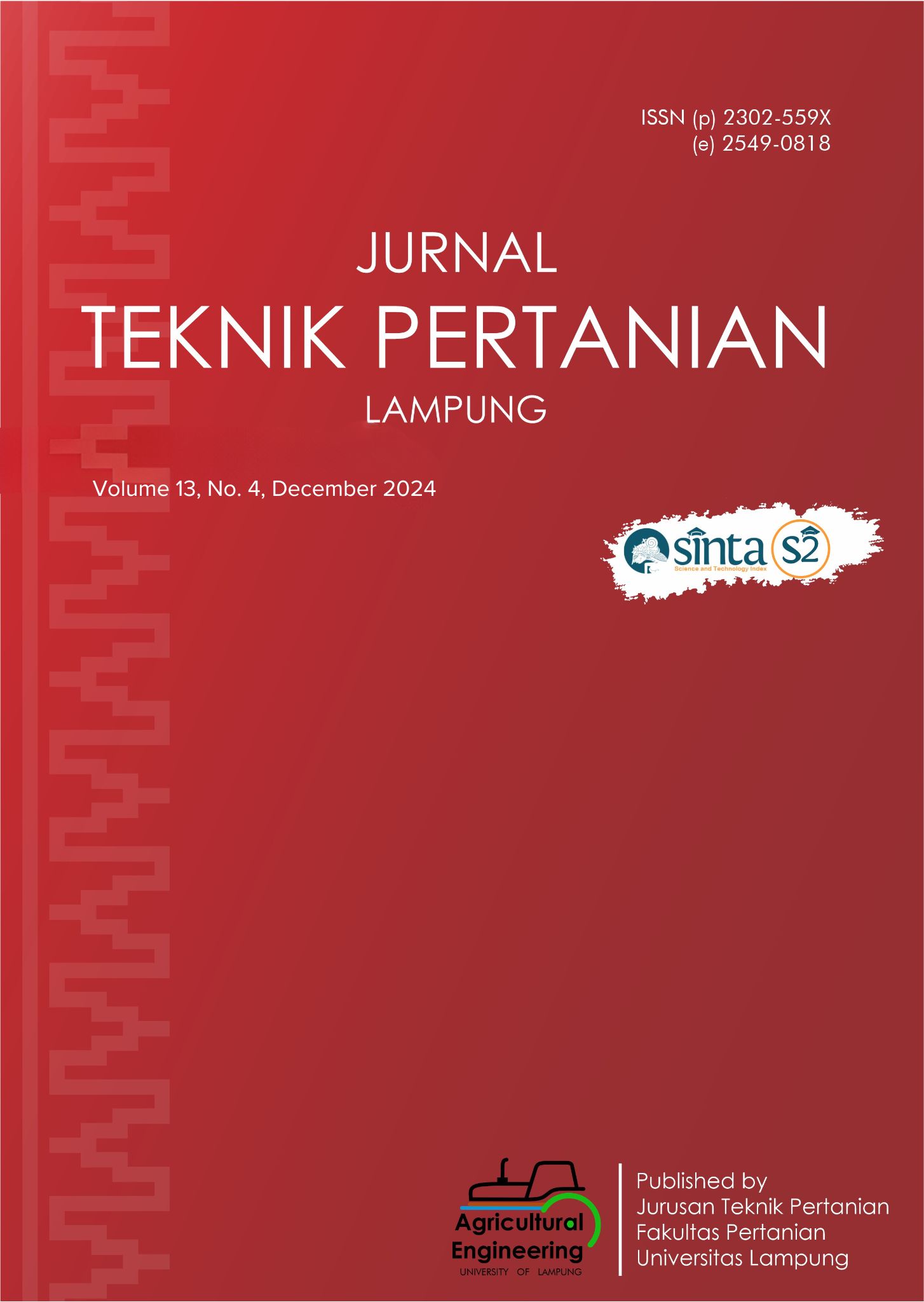Sensory Study and Financial Feasibility Analysis of Alpinia galangal Fish Shredded Products
DOI:
https://doi.org/10.23960/jtep-l.v13i4.1151-1159Abstract
Spices have always been a part of Indonesia's culinary culture. One of the spices that has high economic value and efficacy is galangal. Therefore, testing of bioactive compounds and the effect of making shredded spice fish with the addition of various concentrations of galangal needs to be further investigated in terms of sensory quality and financial feasibility. This study aims to determine the bioactive components in galangal spice, determine the best concentration of galangal addition in shredded spiced fish products, and determine the financial feasibility. The research was conducted by making galangal spice and shredded spiced fish at IDAEZ Group MSMEs. Subsequently, the galangal spice was tested for bioactive compound (GC-MS) and then, sensory tests were carried out on shredded fish spices mixed with galangal spices (1%, 2%, 3%). After that, the financial feasibility analysis was calculated. The results obtained showed that there were four main components in galangal spice, such as 5-Eicosenen, (E)-, n-Hexadecanoic acid, oleic acid, and 9-Octadecenoic acid (Z)-, oxiranylmethyl ester. Meanwhile, the best concentration of shredded spice fish was found in treatment P3 (addition of 3% galangal). Lastly, the shredded spice fish was found to be viable with an income of IDR 427,547 per production.
Keywords: Financial feasibility, GC-MS, Galangal, Sensory.
References
Asnidar, A., & Asrida, A. 2017. Analisis kelayakan usaha home industry kerupuk opak di Desa Paloh Meunasah Dayah Kecamatan Muara Satu Kabupaten Aceh Utara. Jurnal Sains Pertanian, 1(1), 39–47.
Bana, A. (2018). Analisis pendapatan usaha agroindustri minyak kelapa murni oleh Kelompok Wanita Tani Fau’ana di Desa Taekas. Agrimor, 3(4), 61–63. https://doi.org/10.32938/ag.v3i4.432
Chori, V. A., Sartika, D., Hidayati, S., S., S.A., and Utomo, T.P. 2023. Reduction of Escherichia coli contamination in vannameii shrimp (Litopenaeus vannamei) using cassava leaf extract (Manihot glaziovii) and noni fruit (Morinda citrifolia L.). Jurnal Teknik Pertanian Lampung, 12(1), 246-254. https://doi.org/10.23960/jtep-l.v12i1.246-254
Darmilayanti, D., Affandi, M.I., & Adawiyah, R. (2020). Pendapatan usaha pengolahan ikan pada KUB Bina Sejahtera di Kelurahan Kangkung Kecamatan Bumi Waras Kota Bandar Lampung. Jurnal Ilmu-Ilmu Agribisnis, 8(3), 387-394. https://doi.org/10.23960/jiia.v8i3.4433
Hartati, W.R., Hidayati, S., Utomo, T.P., Sartika, D., & Suharyono, S. (2024). Characterization of leaf essential oil from nutmeg (Myristica fragrans) cultivated on agroforestry land. Jurnal Sylva Lestari, 12(1), 100–112.
Khusnul, K. (2017). Uji efektivitas ekstrak etanol rimpang lengkuas (Alpinia galanga L.) terhadap pertumbuhan Trichophyton rubrum secara in vitro. Jurnal Kesehatan Bakti Tunas Husada, 17(1), 73-80.
Kusriani, H., & Zahra, S.A. (2015). Skrining fitokimia dan penetapan kadar senyawa fenolik total ekstrak rimpang lengkuas merah dan rimpang lengkuas putih (Alpinia galanga L.). Prosiding Seminar Nasional Penelitian dan PKM Kesehatan, 1(1), 295-302
Kusuma, A.B., & Wiraguna, A.A. (2018). The potential of Indonesian spices: a review on their nutritional and medicinal values. Journal of Indonesian Culinary and Herbal Tradition, 6(2), 45-56.
Riani, M.U. (2023). Analisis kelayakan usaha pembuatan abon ikan patin dan gabus di CV. Cashiela. Fish Scientiae, 13(4), 105-120.
Sartika, D., Ibrahim, G.A., & Julita, S. (2024). Sensory characteristics of shredded spiced fish formulations with different processing treatments. Aquasains, 12(2), 1474–1483. http://dx.doi.org/10.23960/aqs.v12i2.p1474-1483
Sartika, D., Sutikno, S., Yuliana, N., & Syarifah, R.M. (2019). Identification of food natural antimicrobe compound from red dragon fruit peel extract by GC-MS. JTIHP, 24(2), 66-76. http://dx.doi.org/10.23960/jtihp.v24i2.66-76
Sartika, D., Susilawati, S., Yuliana, N., & Rusita, R. (2020a). Diseminasi hasil riset antimikroba alami berbasis pemanfaatan limbah kulit buah menjadi soft soap herbal di Sentra Industri Keripik Pisang Lampung. JPP IPTEK, 4(2), 75-83.
Sartika, D., Susilawati, S., & Yuliana, N. (2020b). Diseminasi hasil riset anti mikroba alami berbasis pemanfaatan limbah kulit buah menjadi sabun mandi cair bandotan di Sentra Industri Keripik Pisang. Dinamisia: J. Peng. Kepada Masy., 4(4), 655-660.
Sartika, D., Ibrahim, G.A., Ayunisa, P M., & Julita, S. (2023a). Komponen Bioaktif Rempah-Rempah. Pusaka Media. Lampung.
Sartika, D., Ayunisa, P.M., & Susilawati, S. (2023b). Kajian potensi dan analisis biaya pada pembuatan hand sanitizer ekstrak daun waru (Hibiscus tiliaceus). Agroindustrial Technology Journal, 7(1).
Septiawan, Rochdiani, D., & Yusuf, M.N. (2017). Analisis biaya, penerimaan, pendapatan dan R/C pada agroindustri gula aren. Jurnal Ilmiah Mahasiswa Agroinfo Galuh, 4(3), 360–365.
Sidabutar, E.W., Tety, E., & Tarumun, S. (2018). Analisis pendapatan agroindustri tahu Sumedang “Studi kasus agroindustri tahu Sumedang Bapak Osmandri†di Desa Tanah Merah Kecamatan Siak Hulu Kabupaten Kampar. Peekbis Jurnal, 10(2), 147–157.
Sinambela, T.A., Putri, R.M.S., & Apriandi, A. (2020). Pemanfaatan daging trimmed dan belly ikan todak (Tylosurus crocodilus) pada pembuatan abon ikan. Jurnal Teknologi Pertanian, 9(1), 30–42. https://doi.org/10.32520/jtp.v9i1.1016
Thoriq, A., Herwanto, T., & Sudaryanto, S. (2017). Analisis ekonomi dan nilai tambah produksi emping jagung di Desa Cimanggung, Kecamatan Cimanggung Kabupaten Sumedang. Jurnal Teknik Pertanian Lampung, 6(1), 11–22.
Utami, S., Astuti, S., Herdiana, N., & Sartika, D. (2023). Formulasi tepung kacang hijau dan tepung tapioka terhadap sifat sensori nugget ikan swanggi (Priacanthus tayenus). Jurnal Agroindustri Berkelanjutan, 2(2), 284-297.
Yuliani, Y., Septiansyah, A., & Emmawati, A. (2021). Karakteristik organoleptik dan kadar serat kasar abon dari formulasi daging ikan patin dan jantung pisang kepok. Journal of Tropical AgriFood, 3(1), 23–30. https://doi.org/10.35941/jtaf.3.1.2021.5485.23-30
Downloads
Published
Issue
Section
License
- Authors who publish with this journal agree to the following terms:
- Authors retain copyright and grant the journal right of first publication with the work simultaneously licensed under a Creative Commons Attribution-ShareAlike 4.0 International Lice that allows others to share the work with an acknowledgement of the work's authorship and initial publication in this journal.
- Authors are able to enter into separate, additional contractual arrangements for the non-exclusive distribution of the journal's published version of the work (e.g., post it to an institutional repository or publish it in a book), with an acknowledgement of its initial publication in this journal.
- Authors are permitted and encouraged to post their work online (e.g., in institutional repositories or on their website) prior to and during the submission process, as it can lead to productive exchanges, as well as earlier and greater citation of published work (See The Effect of Open Access).
Jurnal Teknik Pertanian Lampung

JTEPL is licensed under a Creative Commons Attribution-ShareAlike 4.0 International License.

